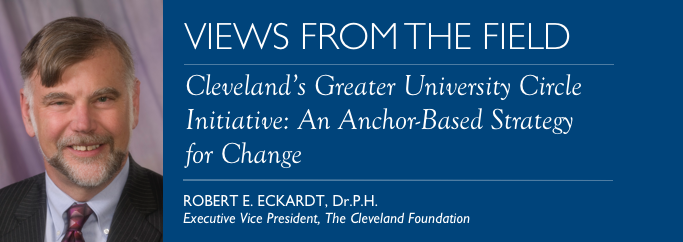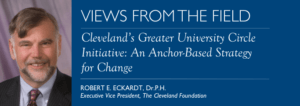
Cities are increasingly turning to their “anchor” institutions as drivers of economic development, harnessing the power of these major economic players to benefit urban neighborhoods. This is especially true for cities that are struggling with widespread poverty and disinvestment. Urban anchors – typically hospitals and universities – have sometimes isolated themselves from the poor and struggling neighborhoods that surround them. But this is changing. Since the late 1990s, as population, jobs, and investment have migrated outward, these “rooted in place” institutions are becoming a key to the long, hard work of revitalization. In Cleveland, the Greater University Circle Initiative is a unique, multistakeholder initiative with a ten-year track record.
Cleveland has won national attention for the role major nonprofits are playing in taking on the poverty and disinvestment plaguing some of the poorest neighborhoods in the city. Where once vital university and medical facilities built barriers separating themselves from their neighbors, now they are engaging with them, generating job opportunities, avenues to affordable housing, and training in a coordinated way. Where once the institutions may have viewed each other as mere competitors for funding or clients, now they are allies finding ways to improve their surrounding neighborhoods, and cooperate on savings through joint business operations.
Ten years ago the Cleveland Foundation first convened the Greater University Circle Initiative. This has achieved coordination among three larger anchor institutions located in Cleveland’s University Circle area – almost one-square mile of world-class educational, cultural, and health institutions. Through this initiative, the Cleveland Clinic, University Hospitals, and Case Western Reserve University networked and deployed their resources in a powerful challenge to the persistent poverty and disinvestment in seven surrounding neighborhoods.
Where once a major institution might only seek to gentrify its surrounding area by pushing out impoverished residents, this strategy looks for ways to improve the prospects and income of the 60,000 people who live in these neighborhoods. The Greater University Circle Initiative seeks to reweave community networks, in part through community engagement, to improve the quality of life in surrounding neighborhoods, and to give residents a greater voice and connection to the resources of the anchor institutions.
The initiative includes other strategic partners, among them the City of Cleveland, neighborhood and workforce development entities, business accelerator organizations, and the evaluation partner, Cleveland State University. It is convened, supported, and led by the Cleveland Foundation. It focuses on building and sustaining the relationships of the partners and their commitment to meeting goals that they broadly identified as: Hire Local, Live Local, Buy Local, and Connect. I hope that the Greater University Circle Initiative – and the Economic Inclusion Management Committee (EIMC) created to support the work – can serve as models for effective, durable, anchor-based strategies nationwide.
An important tool was the Economic Inclusion Management Committee (EIMC) because it drove much of the day-to-day work of the Greater University Circle Initiative. Consisting of directors and managers from each of the participating organizations, this group is charged with implementing the goals, once they are determined by leadership. It began meeting in 2011, five years after the Greater University Circle Initiative formed. Its collaborative, patient work has resulted in new policies and practices within each anchor institution, as well as in new collaborative projects that are creating jobs, income, and ownership opportunities for residents. It is the networks and relationships resulting from all of these interconnected efforts that are the “glue” that holds the whole thing together. If there is a “secret sauce,” this might be it.
Lessons Learned
From 10 years of work, five critical elements account for the success of this anchor-based strategy:
- Initiatives involving more than one anchor must have a convener – a trusted, central player with some clout (money, influence, power) to bring and keep people together. The Cleveland Foundation has been very successful in this role. Philanthropy, with its combination of intellectual, financial, and social capital, is a natural choice. In some cities, a municipality might play this role – however, inevitable changes as one administration yields to another may create some risk.
- There must be assets to build on – hospitals, universities, nonprofit, or corporate players who are willing partners. In my view, residents also must be engaged in an asset-based, network-building effort. In Cleveland, our unusual multistakeholder model includes three key anchors. As the work has grown, additional partners have joined the work, and we have broadened our concept of “anchor institution” to include both the City of Cleveland as well as the Cleveland Foundation itself.
- There must be a source of funding to pay for staffing and programming. It can be possible to use loaned staff, interns, fellowships, and other low-cost options, but this will still require a commitment of time and resources. Unless there is funding on the table for key pilot programs and initiatives, it is unlikely you will see significant change.
- Start in safe spaces. We began in physical development and then added jobs and procurement. Given the tradition of clinical competition between the hospitals, only recently have we incorporated community health, after the health institutions were comfortable working together on other issues. Currently they are working jointly on lead issues and infant mortality.
- Focus on culture change. To open up anchors to changing hiring and procurement culture, change MUST go deep into the institution. Existing ways of hiring or procurement must be changed. This means looking at internal rules, employment incentives, and how long term change is supported. Otherwise, there may be pronouncements from the top with little real change in institutional performance.

